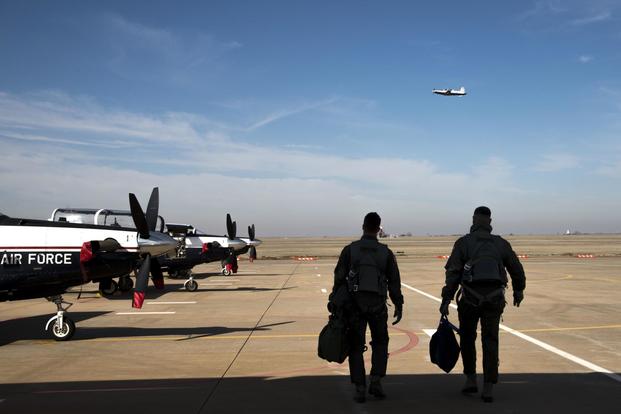The Air Force is speeding up efforts to have pilots fly roughly 20 hours a month, on par with the other services, Chief of Staff Gen. David Goldfein said Wednesday.
Echoing similar statements made by Air Force Secretary Heather Wilson earlier this month, Goldfein said there is a big push to get pilots more flight time, in tandem with producing more pilots in the ranks.
He said Air Force pilots currently average 17.8 hours a month, adding, "We are flying at the same rate as the Marine Corps, the Navy -- all the services are flying the same."
Lawmakers in recent weeks have questioned the Air Force's numbers after Marine Corps officials testified that Marines have been flying between 14 to 16 hours a month, with the Air Force flying only nine or 10 hours by comparison.
Related content:
- T-6 Trainers Restart Flights after Rash of Unexplained Pilot Symptoms
- Air Force Pilot Shortage Climbs to 2K Pilots, General Says
- USAF Short About 200 Maintainers, Pilot Training Continues: SecAF
"We've dug into the details and analyzed the issue. It really comes down to two areas that we are investing in and focused on," Goldfein said before a House Appropriations Defense subcommittee hearing alongside Wilson. "One is how many pilots we produce and then, two, how many pilots we retain, because you have to get both of those right."
He said the service is on track to reach its 1,400 pilot-per-year goal, but not for another couple of years.
"And we'll achieve that in 2020. We're going to work our way into 1,200 pilots a year, 1,300 pilots a year, 1,400 pilots a year," Goldfein said.
One setback to that goal is the recent grounding of T-6 Texan II trainers, used for pilot orientation and training flights, over unidentified physiological episodes, he said.
Air Education and Training Command on Feb. 1 ordered an indefinite operational pause for all T-6 aircraft at Columbus Air Force Base, Mississippi; Vance Air Force Base, Oklahoma; and Sheppard Air Force Base, Texas, over incidents officials said were not classical cases of hypoxia, which is caused by oxygen deprivation. The episodes still had adverse effects on pilots while in flight, however.
While pilots experienced similar symptoms -- disorientation, shortness of breath, confusion, wheezing -- an obvious root cause has not been found. Investigators are still working the incident.
“We're on track, right now, to get to 275 [T-6] aircraft back in the air of the 444. And we'll have the remainder flying this summer,” Goldfein said.
The grounding has since been lifted, but it forced the Air Force to cancel at least one class of pilots going through the pipeline, backlogging 82 students until flight training resumed.
Goldfein on Wednesday said the pause created a gap in pilot training, and thus the service will not meet its end-of-the-year pilot production goal.
"We're going to be about 200 short of that," he said, without referencing where the service stands at the moment on pilot numbers.
"While we are 2,000 pilots short right now, I think it's very important to know that we are not short in the operational field. We're manning the operational field and cockpits [at] 98 percent to 100 percent," Goldfein said.
-- Oriana Pawlyk can be reached at oriana.pawlyk@military.com. Follow her on Twitter at @Oriana0214.













